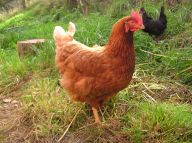No, it’s not a joke. It’s me introducing my appendagely-challenged hen called Monkey who is stoically and bravely living life on one leg.
 She began life with a full complement of legs. I bought her from a farmer along with a couple of others as they had reached their 18-month sell-by date and were due for the chop. Things were fine for about 6 months until I found her one day, dragging her leg along, obviously broken. A trip to the vet confirmed that the leg was broken in two places, above and below the ankle. How did it happen? And what was I going to do?
She began life with a full complement of legs. I bought her from a farmer along with a couple of others as they had reached their 18-month sell-by date and were due for the chop. Things were fine for about 6 months until I found her one day, dragging her leg along, obviously broken. A trip to the vet confirmed that the leg was broken in two places, above and below the ankle. How did it happen? And what was I going to do?
I never found out how Monkey broke her leg, but my prime suspect was the goat whose clumsy hooves could well have trodden on her. The chooks do have a dangerous habit of winding around the sheep and goats’ legs at feeding time.
More Than Just A Roast
Regardless of the cause, the result was clear. One beloved chook with a badly broken leg that needed to be amputated. Two vets had two opinions. One, to put her down because with one leg her balance would be impaired (especially in a fat, top-heavy hen) and she would use her wing for balance with a chance that she’d topple and break it. But the second vet was more sympathetic and understood that this animal was more than just a roast to me and offered to do the operation if I was aware of the potential balance difficulties.
 What to do? What I wanted to do was ask Monkey whether she preferred to live with one leg or say goodbye to life. As I couldn’t, I based my decision on the idea that animals (excluding us complex humans) have a drive for survival so they would rather opt for life, regardless of its difficulties.
What to do? What I wanted to do was ask Monkey whether she preferred to live with one leg or say goodbye to life. As I couldn’t, I based my decision on the idea that animals (excluding us complex humans) have a drive for survival so they would rather opt for life, regardless of its difficulties.
Poultry In Motion
The operation went fine. The leg was gone. Monkey took a little while to get used to hopping but now can go at quite a fast pace, especially when tempted over with her favourite treat – grapes. She lives in a converted dog kennel with low ramp for her ease of access. She doesn’t perch anymore but sleeps on the ground so it’s essential to keep her closed up safely at night. Biggest predator – wait for it – hedgehogs! I’ll blog that story another time.
Is she happy? Was it the right decision? Who knows but she’s got a great appetite, coos sweetly when you ‘tuck’ her up at night and probably has the best muscle-toned chicken leg around. Note – not for eating.
Have a look at this article, its a similar story of a chook who lost a leg although my chook doesn’t stand on my head!
I love the story. Good to see a picture of your chicken at last.
LikeLike
What a heartwarming story! And thank you for the picture of the “chook tray” too – I have been wondering how to get good quality food into my henhouse and you have shown me the way forward.
Looking forward to the hedgehog blog!
LikeLike
Let me know how you get on with the chook tray. I plant grass seed (a particular grass that chooks love). It works a treat. Fresh veggies with all the convenience.
LikeLike
[…] This particular chook house was a converted dog kennel used by two of our chooks, Big Foot and one-legged Monkey. There are no perches inside and the two chooks spent every night safe and snuggled on the […]
LikeLike
Thanks for directing me here–I love your stories! When we had horses we had numerous chicken legs broken because as soon as the horses pooped the chickens would run in to pick out the undigested kernels (I know, yuck!). Then they would get stepped on. Most breaks were in the toes and healed fine, usually falling off. One was quite bad, up above the knee. We had to isolate her for about two weeks but it did heal, and she walked with a limp. We had no idea what to do to stop this from happening. Then the horses got too fat, we stopped graining them, and their poop became less interesting–problem solved!
LikeLike